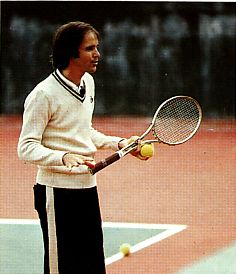THE AMAZING STORY OF THE EVOLUTION OF THE INNER GAME
Inner Game Beginnings

As a young man on sabbatical, I spent a summer as a tennis coach. At the outset of one particular tennis lesson, I decided to delay teaching only to find that the student increased his rate and enjoyment of learning much faster than he had when I was actively teaching him. Feeling a bit threatened that I wouldn’t get due credit, I stopped and realized I was more committed to teaching than to the student learning. I decided to reverse my priorities. “Where does learning happen, and what’s going on inside the head of the student while the ball is approaching?” It was obvious. My should and shouldn’t teaching instructions were creating self-doubt, self-criticism, too much effort, and overly tight strokes.
When I replaced the traditional control mechanism of should and shouldn’t with invitations to try heightened awareness and relaxed concentration, the student learned naturally by using what felt good and what worked. This is how we all learned as children to crawl, walk, and run. In the use of simple awareness, three things reliably increased: rate of learning, enjoyment of play, and the student’s confidence that they could learn from experience.
Following the success of the inner game in individual and team sports, the corporate world took interest, followed by the emergence of life coaching and corporate coaching, a new profession, as did the new profession of sports psychology.
Over the past forty years, I have written seven books on the subject of how to merge inner connection with outer performance. But I’ve often seen this idea become distorted and lost in translation.
From Sport to Corporate Performance
HOW HAS THE INNER GAME CHANGED CORPORATE CULTURE?
 Once upon a time, the Vice President of the largest company in the world took an Inner Game lesson and said: “You’ve found a better way to change.” He hired me to help transform AT&T from an old school monopoly into a modern competitive enterprise.
Once upon a time, the Vice President of the largest company in the world took an Inner Game lesson and said: “You’ve found a better way to change.” He hired me to help transform AT&T from an old school monopoly into a modern competitive enterprise.
Using inner game methods, leaders enjoyed creating a new company and a new buyer centered approach to selling. The technicians became as curious as children, losing their fear of seeming unprofessional, while thousands of telephone operators learned to enjoy and truly benefit from their seemingly routine work. For AT&T, this was a game changer.
SUCCESSFUL COMPANIES USING THE INNER GAME TO EVOLVE
 Apple Computer used The Inner Game of Tennis to develop their revolutionary user-interface design.
Apple Computer used The Inner Game of Tennis to develop their revolutionary user-interface design.
IBM taught their managers The Inner Game approach to coaching, joining the many companies who have redefined work as to focus on encouraging learning and enjoyment as well as performance.
Rolls Royce completed six years of Inner Game training for rising managers, training them to work in teams using heightened awareness of respect, participation, responsibility, and non-judgmental focus on self determined critical variables.
The Inner Game helped launch the professions of life and professional coaching as well as the field of sports psychology through which some of the most successful professional coaches including Pete Carroll and Steve Kerr, have demonstrated uncanny success by emphasizing the human dimension of their sports as an essential part of pursing excellence.
Leading companies like these and many others have thrived in their attempts to combine the inner element with organizational discipline and know how and thousands of companies have been launched to facilitate these changes. I believe this momentum can only grow. Those that embrace the development of our humanity and combine it with the skills needed to achieve our external goals will continue to learn and thrive. Those who don’t will find it increasingly difficult to get the best people and the best results.
Apple Computer Utilizes
Inner Game Techniques
Leading Apple Designer Alan Kay used Inner Game principles to train interface designers. In this video, Alan Kay shows a film based on The Inner Game of Tennis. The film contrasted the speed at which two students learn to play tennis. The first student was told to meet the ball at a certain angle a certain stage of its bounce, in other words, the full abstract teaching treatment. The second student was told to “make the ball go over the net.” The first student experienced frustration and a serious case of clumsiness. The second student progressed rapidly and evidently enjoyed himself. Kay naturally tied these concepts to computer interfaces, as this is where his greatest natural ability lies. Listen to his take and see what it sparks in you.
Connect with the Inner Game
We would love to hear from you!
Request a consultation. Send an inquiry.
Share your feedback and questions...
More Info
Tim Gallwey lives in Thousand Oaks CA, and when he isn’t touring the globe on speaking engagements, he’s facilitating workshops and The School in LA, and working on ways to make the applications of the Inner Game more accessible internationally to corporations and various conventions on coaching, learning, and peak performance and most importantly continuing to learn more and more in his own understanding the inner dimension of his own life..
Address:
14011 Ventura Blvd Suite 502, Sherman Oaks CA 91432


